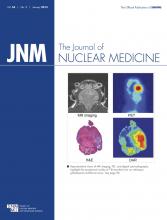Abstract
The prognosis of patients with locally advanced breast cancer (LABC) remains poor. We prospectively investigated the impact of 18F-FDG PET/CT at initial staging in this clinical setting and compared PET/CT performance with that of conventional distant work-up. Methods: During 60 mo, consecutive patients with LABC (clinical T4 or N2–N3 disease) underwent 18F-FDG PET/CT. The yield was assessed in the whole group and separately for noninflammatory and inflammatory cancer. The performance of PET/CT was compared with that of a conventional staging approach including bone scanning, chest radiography, or dedicated CT and abdominopelvic sonography or contrast-enhanced CT. Results: 117 patients with inflammatory (n = 35) or noninflammatory (n = 82) LABC were included. 18F-FDG PET/CT confirmed N3 nodal involvement in stage IIIC patients and revealed unsuspected N3 nodes (infraclavicular, supraclavicular, or internal mammary) in 32 additional patients. Distant metastases were visualized on PET/CT in 43 patients (46% of patients with inflammatory carcinoma and 33% of those with noninflammatory LABC). Overall, 18F-FDG PET/CT changed the clinical stage in 61 patients (52%). Unguided conventional imaging detected metastases in only 28 of the 43 patients classified M1 with PET/CT (65%). 18F-FDG PET/CT outperformed conventional imaging for bone metastases, distant lymph nodes, and liver metastases, whereas CT was more sensitive for lung metastases. The accuracy in diagnosing bone lesions was 89.7% for planar bone scanning versus 98.3% for 18F-FDG PET/CT. The accuracy in diagnosing lung metastases was 98.3% for dedicated CT versus 97.4% for 18F-FDG PET/CT. Conclusion: 18F-FDG PET/CT had the advantage of allowing chest, abdomen and bone to be examined in a single session. Almost all distant lesions detected by conventional imaging were depicted with PET/CT, which also showed additional lesions.
Footnotes
Published online Dec. 4, 2012.
- © 2013 by the Society of Nuclear Medicine and Molecular Imaging, Inc.







